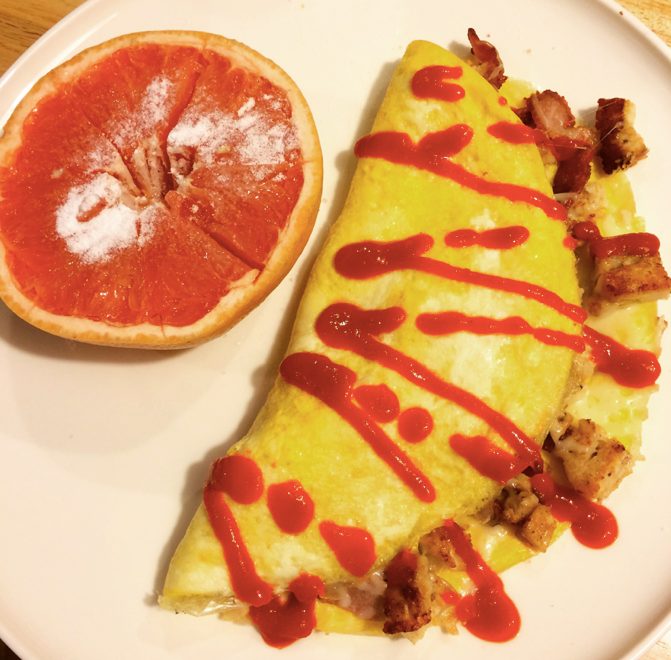Why do I love protein?
Because it’s anabolic [3] and is positively associated with lean body mass [4].
Because it increases satiety [5].
Also, meat is delicious [6].
(And yes, while it’s true that muscle protein synthesis (MPS) is maximally stimulated at 30g protein [7], it’s not inherently harmful to consume more than that in one sitting. So if you know that you’ll be short on protein later on, go ahead and load up.)
Around two hours after breakfast would be when I’d recommend getting in a workout, if possible (see above).
After that, maybe a scoop of whey protein and perhaps some form of carbohydrate before you head out the door. The reasoning for this is two-fold: one, it’s simply another opportunity to ingest protein before the festivities begin; and two, whey protein stimulates MPS [8] – this is good! As far as the carbohydrate, there does appear to be some evidence indicating that carbohydrate has an additive effect on MPS [9].
Don’t worry too much about meal frequency. You won’t retain more fat simply because you consumed three larger meals today, and conversely, you won’t burn more fat by eating more frequently [10]. From a practical standpoint, you may find it easier to consume bigger, less frequent meals, simply because it affords you the ability to squeeze in more calories per feeding.
And finally, you may be wondering about nutrient timing. How soon after you workout should you have your post-workout meal? A review by Alan Aragon and Brad Schoenfeld suggests that the evidence is not as we once thought. More specifically, they indicate that the pre- and post-workout meal should not be separated by more than 3-4 hours given a 45-90 minute resistance training bout [11]. So relax. This means there’s no need to panic and chug down a protein shake the minute you put down the dumbbells (I admit that I used to do this – whoops!), and you can simply eat whenever the next opportunity presents itself.
If you’re counting macros – and even if you’re not – it may be a good idea to save up a good portion of your carbohydrate and fat allotment for the evening. This is especially important if you’re on a tight deadline and have a good reason to have to be strict with your diet.
Above all, don’t forget that total calories (followed secondarily by macronutrient intake) for the day will matter the most.
Mindset
Woo! My favorite topic, and arguably the most difficult aspect for many individuals to master.
First off, don’t freak out. The whole point of attending a social event is to have a good time, right?
Counterregulatory eating, more colloquially known as the “what the hell effect”, is all too common. Popularized by Roy Baumeister, the term describes the phenomenon in which dieters binge once they’ve had a small taste of something that they’ve deemed forbidden [12]. This food bender may last for one meal, one weekend, a week, or even a whole month. As Baumeister so aptly explains, dieters rationalize this behavior by thinking that “[v]irtue cannot resume until tomorrow,” so they proceed to stuff their faces while they can.
You may have experienced this. I’ve certainly been guilty of this in the past. And I can guarantee you that it’s no fun.
The best way to prevent this from happening is to not set strict black-and-white rules to begin with. As soon as you set a food off-limits in your mind – say, your favorite m&m ice cream sandwiches – then all of a sudden, simply sitting there actively resisting the treat depletes your willpower [13]. (In contrast, non-dieters, or those who had not set the food off limits, experienced zero willpower depletion.) This is no bueno if you want to succeed in the long term.
I understand that it can be hard to embrace the idea that you can have one cookie and not derail all your progress. There’s nothing sexy about moderation, after all.
But.
Remember that you’re going into this with the intention of having a good time. You can have your cake and eat it, too.
So relax.
Be mindful about what you eat and stay in the moment. Pile up on protein and veggies at the event if that’s available. If not, don’t worry. Because though you may not always be able to control what you eat, you can always, always control how much.
You’re in charge here. You get to decide when to put the fork down. You get to say when enough is enough.
Trust that you have all the mental tools you need to succeed.
And finally: If all of this seems like waaaay too much work for you, then forget about it. Not everything is worth stressing out over, and if you’d rather just coast into a barbecue and wing it, that is totally okay.
You do you.



